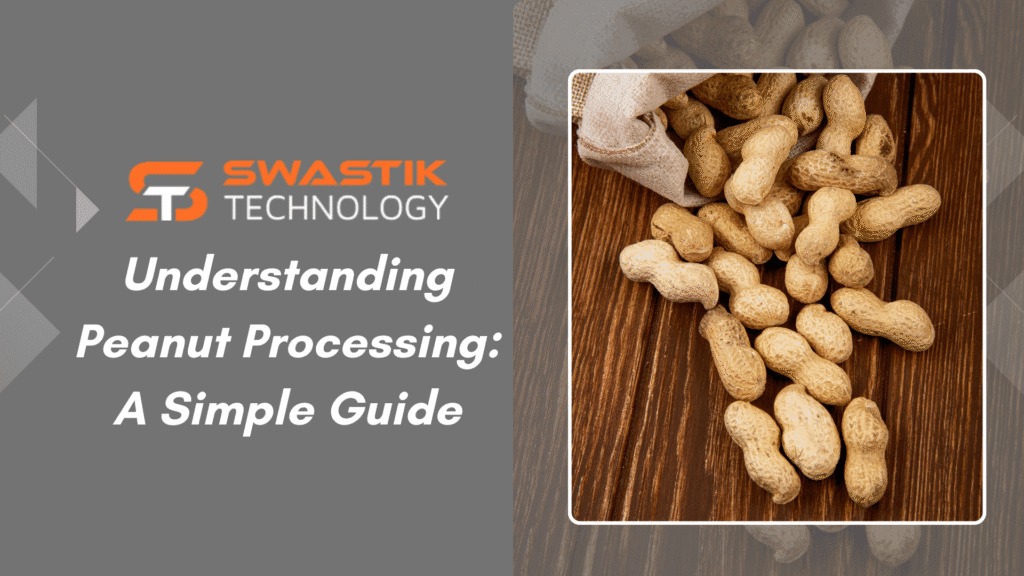
Peanuts, also known as groundnuts, are more than just a tasty snack. They are one of the world’s most valuable crops, used in everything from edible oil and butter to confectionery, animal feed, and industrial products. But before peanuts reach the consumer, they go through a carefully planned process that ensures quality, safety, and efficiency.
This process, known as peanut processing, involves cleaning, shelling, grading, drying, and packaging. To achieve this at scale, modern plants use advanced machinery that saves time, reduces waste, and delivers consistent results.
In this blog, we’ll walk through the journey of peanut processing step by step and highlight the essential machinery for a groundnut processing plant that makes it possible.
Step 1: Harvesting and Initial Preparation
Once the crop is ready, peanuts are harvested from the fields and dried to reduce moisture. At this stage, they often contain soil, stones, stems, and other impurities. This raw condition makes peanut cleaning the first and most important step.
Step 2: Cleaning and Separation
The first task of a peanut processing plant is to remove all impurities and ensure only clean, healthy kernels move forward. Several machines play a role here:
- Destoner: This machine removes stones, metal particles, and magnetic impurities that could damage equipment or compromise food safety.
- Gravity/Multi Gravity Separator: It ensures precise separation of good kernels from lighter impurities such as dust, husks, and damaged peanuts.
👉 Together, these machines protect the entire processing line and ensure high-quality output from the very beginning.
Step 3: Shelling – Unlocking the Kernels
Once cleaned, peanuts are ready for shelling. Shelling machines crack open the hard shells and release the kernels. Compared to manual shelling, modern shellers are faster, more efficient, and minimize kernel breakage.
Shelling sets the stage for grading and ensures that only kernels of usable quality enter the next stage.
Step 4: Grading and Sorting
Not all peanuts are the same. Some are large, others small, and some may not meet quality standards. Grading helps classify them into uniform groups, improving consistency and value.
A groundnut processing plant uses different graders for specialized tasks:
- Grader/Screen Grader: Separates peanuts according to size using mesh screens.
- Round Grader: Ideal for specialized grading where circular movement helps separate kernels more accurately.
- Grading Grader: Improves overall grading efficiency and ensures consistent batches.
👉 With these machines, processors can supply peanuts that meet local and international market demands, whether for snacks, butter, or oil extraction.
Step 5: Drying the Peanuts
Even after shelling and grading, peanuts need to have the right moisture content to stay fresh and safe. Excess moisture can lead to mold growth and aflatoxin contamination, which is a major concern in exports.
That’s why a dryer is an essential part of any peanut processing system. By reducing peanuts to optimal moisture levels, it ensures longer shelf life and maintains food safety standards.
Step 6: Moving Materials Efficiently
A modern processing plant isn’t just about machines that clean, shell, or grade. Smooth internal movement of materials is equally important.
- Z-Type Elevator: Designed for vertical lifting, this elevator ensures safe and gentle transport of peanuts without damage.
- Loading Lift and Conveyor Belt: These systems keep the plant running efficiently by moving peanuts between different machines without manual effort.
👉 Together, these systems save time, reduce labor costs, and keep production flowing smoothly.
Step 7: Packaging and Storage
Once peanuts are cleaned, shelled, graded, and dried, they are ready for packaging. Depending on the end market, peanuts may be vacuum-sealed, nitrogen-flushed, or packed in bulk bags. Proper packaging and storage in cool, dry spaces ensure the final product reaches consumers or buyers in top condition.
Essential Machinery for a Groundnut Processing Plant
To summarize, here are the key machines that make peanut processing seamless:
- Destoner – removes stones and magnetic impurities.
- Gravity/Multi Gravity Separator – separates kernels from lighter impurities.
- Peanut Shelling Machine – cracks shells and delivers kernels.
- Grader/Screen Grader – sorts peanuts by size.
- Round Grader – handles specialized grading needs.
- Grading Grader – boosts grading efficiency.
- Dryer – ensures correct moisture levels for safe storage.
- Z-Type Elevator – lifts peanuts vertically with care.
- Loading Lift and Conveyor Belt – ensures smooth movement across the plant.
Together, these machines form a complete peanut processing plant that delivers efficiency, safety, and high-quality output.
✅ Final Thoughts
Peanut processing may seem simple on the surface, but behind every packet of roasted peanuts or jar of peanut butter lies a well-organized system powered by advanced machinery. From the Destoner that ensures purity to the dryer that preserves freshness, every machine plays a role in delivering safe, high-quality peanuts to the market.
For farmers, entrepreneurs, and food processors, understanding this journey is the first step. For businesses, investing in the right peanut processing is the key to staying competitive and profitable in a fast-growing global industry.
At the end of the day, peanuts may be small—but when processed right, they can create big opportunities.